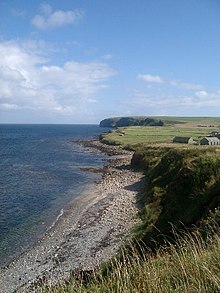Windwick Broch
Coordinates: 58 ° 46 ′ 9 ″ N , 2 ° 56 ′ 22 ″ W.
The Windwick Broch (also Cairns o 'the Bu) is located on a prominent headland on the Scottish island of South Ronaldsay on the east coast of the island that belongs to the Orkneys . The associated place is called Linklater.
Near the Winwick Broch is the Windwick Basement, discovered in 1901 and now excavated by M. Carruthers . The Earthhouse is just one of a series of buildings on the site that was exposed in 2007.
When the rubble was removed, the oldest brochure-like structure erected on the slope was reached . Although it looks like a brochure and is built to the same design and in similar proportions, it lacks the double-walled wall, as is often observed on Orkney.
description
The massive wall, around five meters thick, has an outer diameter of 21.5 m and an inner diameter of 11.3 m. That made Windwick a little bigger than the Gurness and Midhowe brochures on Rousay . Although the interior is large, the brochure need not have been tall. The structure rather resembles the Early Iron Age Broch from Crosskirk , in Caithness , which was considered to be derelict. When work began in Crosskirk, it became clear that it was not worn. It was built before the typical Brochs and was not a tower in the usual sense.
A teardrop-shaped cell was found on the southwest wall of Windwick Broch. Charcoal and lots of logs were found around the entrance , along with whalebone that showed scorch marks. The finds also included heaps of unworked whalebone, pottery and an iron knife. The remains of red deer were also considerable. The amount of whalebone raises the question of whether it was preferably processed here. It comes from different species of animals, including whales . Since such frequent strandings of whales are very unlikely, they were probably hunted. The pottery comes from the Middle to Late Iron Age - around 500 BC. BC - that is earlier than in Gurness. A number of foundations in the southeast of the entrance could be building remains, similar to those found around Gurness. Agricultural implements and tools were also found in the brochure. There are references to grain processing on the hill . A millstone was found near Windwick . A number of post holes have been discovered on the hill.
A further trench was dug around the Broch during the excavation in order to examine the extent of the development. A dark silty area some distance from the facility represents a backfilled trench that usually surrounded Brochs. On the western side, an earth wall indicates that a wall and a moat existed.
After the brochure went out of use, at least one secondary building was built. A breach was cut in the rubble to build a new structure. Inside these were the remains of at least one hearth with a thick layer of burned material. The stones next to the stove could belong to a second stove. Outside, the archaeologists found evidence of metalworking in the form of slag and other materials. In a later phase, part of the collapsed masonry of the Broch was cleared away, presumably to enable the construction of the neighboring second Broch.
The basement
In the case of the basement, a basic distinction is made between "rock-cut", "earth-cut", "stone built" and "mixed" basements. The last building on the site was the basement dug into the rubble of the oldest brochure . Basements built into the remains of the Brochs are unusual, but there are a few on Orkney. They are usually at the beginning of the use of a space. In this case, the construction of the Windwick basement appears to have marked the end and its excavation to have decisively changed our knowledge of the function of such systems. As a rule, it is a system of underground passages and chambers or niches that are cut into the earth (earth cut) or into rock (rock cut), made of wood (rarely), or set in stone (stone built) mixed construction (mexed) and covered with stone slabs or wooden beams.
See also
literature
- John W. Hedges: Bu, Gurness and the brochs of Orkney (= British Archaeological Reports. British series. 163-165). 3 volumes. Oxford, BAR 1987.
Web links
- Online mapping service for UK - at Search Suckquoy enter Suckquoy is the nearest place to choose in the hit list and the second entry down a bit at the shoreline walk.
- Description in English and pictures
- The basement
- Entry on Windwick Broch in Canmore, Historic Environment Scotland database

